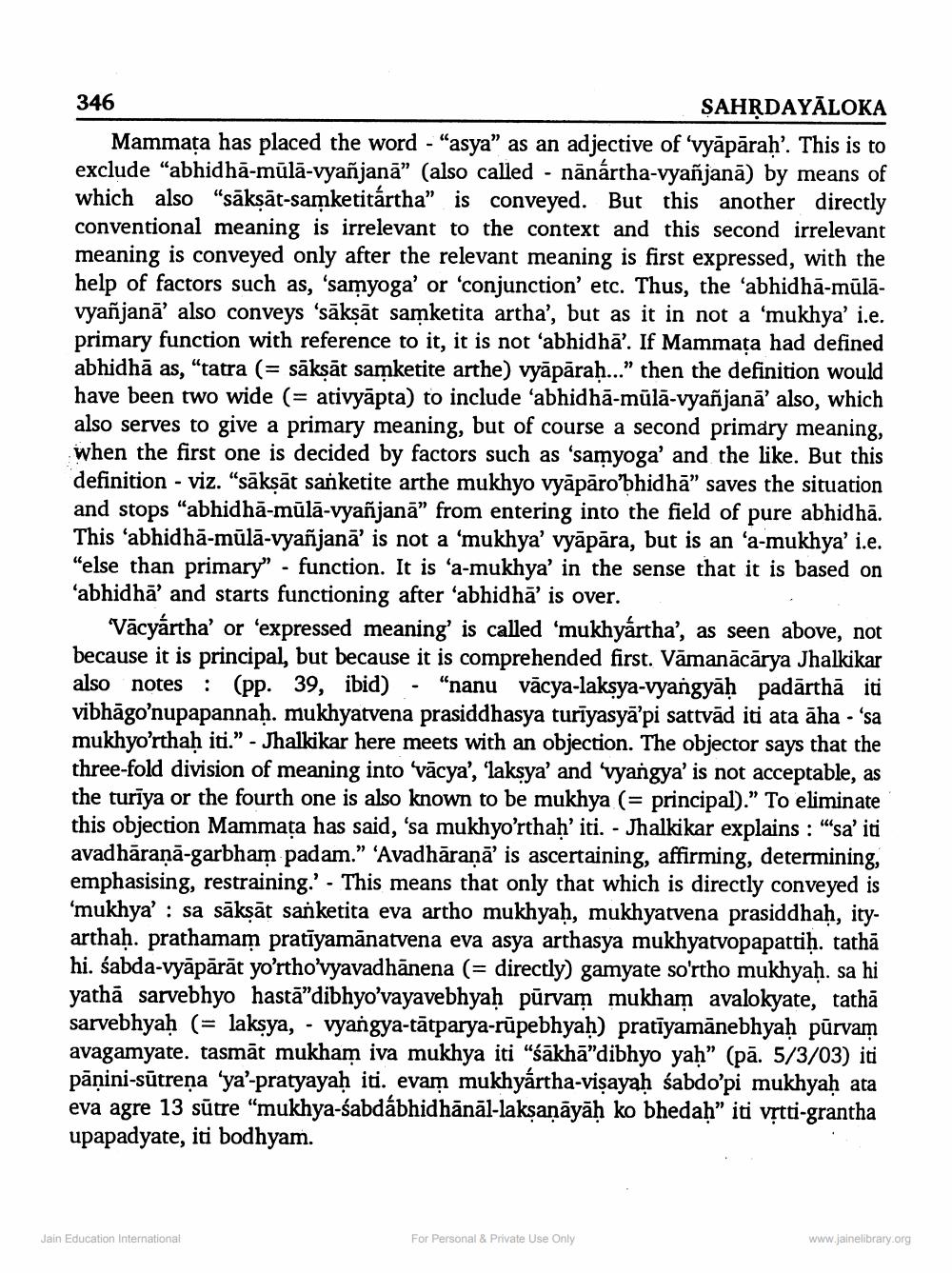________________
346
SAHRDAYĀLOKA Mammata has placed the word - "asya" as an adjective of 'vyāpāral exclude "abhidhā-mūlā-vyañjanā” (also called - nānártha-vyañjanā) by means of which also "sāksāt-samketitártha" is conveyed. But this another directly conventional meaning is irrelevant to the context and this second irrelevant meaning is conveyed only after the relevant meaning is first expressed, with the help of factors such as, 'samyoga' or 'conjunction etc. Thus, the 'abhidhā-mülāvyañjanā' also conveys 'sākṣāt samketita artha', but as it in not a 'mukhya' i.e. primary function with reference to it, it is not 'abhidhā'. If Mammata had defined abhidhā as, "tatra (= sāksāt samketite arthe) vyāpārah..." then the definition would have been two wide (= ativyāpta) to include 'abhidhā-mūlā-vyañjanā' also, which also serves to give a primary meaning, but of course a second primary meaning, when the first one is decided by factors such as 'samyoga' and the like. But this definition - viz. "sāksāt sanketite arthe mukhyo vyāpāro bhidhā” saves the situation and stops "abhidhā-mūlā-vyañjanā” from entering into the field of pure abhidhā. This "abhidhā-mūlā-vyañjana' is not a 'mukhya' vyāpāra, but is an 'a-mukhya' i.e "else than primary" . function. It is 'a-mukhya' in the sense that it is based on abhidhā' and starts functioning after abhidhā' is over.
Vācyártha' or 'expressed meaning' is called 'mukhyártha', as seen above, not because it is principal, but because it is comprehended first. Vāmanācārya Jhalkikar also notes : (pp. 39, ibid) - "nanu vācya-laksya-vyangyāḥ padārthā iti vibhāgo'nupapannaḥ. mukhyatvena prasiddhasya turīyasyā'pi sattvād iti ata āha - 'sa mukhyo’rthaḥ iti.” - Jhalkikar here meets with an objection. The objector says that the three-fold division of meaning into vācya', laksya' and 'vyangya' is not acceptable, as the turīya or the fourth one is also known to be mukhya (= principal).” To eliminate this objection Mammata has said, 'sa mukhyo'rthah' iti. - Jhalkikar explains : "sa' iti avadhāraņā-garbham padam.” 'Avadhāraņā' is ascertaining, affirming, determining, emphasising, restraining.' - This means that only that which is directly conveyed is ‘mukhya' : sa sākṣāt sanketita eva artho mukhyaḥ, mukhyatvena prasiddhaḥ, ityarthaḥ, prathamam pratiyamānatvena eva asya arthasya mukhyatvopapattiḥ. tathā hi. sabda-vyāpārāt yo’rtho'vyavadhānena (= directly) gamyate so'rtho mukhyaḥ. sa hi yathā sarvebhyo hastā”dibhyo'vayavebhyaḥ pūrvam mukham avalokyate, tathā sarvebhyaḥ (= laksya, - vyangya-tātparya-rūpebhyaḥ) pratīyamānebhyaḥ pūrvam avagamyate. tasmāt mukham iva mukhya iti “śākhā"dibhyo yah” (pā. 5/3/03) iti pāņini-sūtreņa 'ya'-pratyayaḥ iti. evam mukhyártha-visayaḥ śabdo’pi mukhyah ata eva agre 13 sūtre “mukhya-sabdábhidhānāl-laksaņāyāḥ ko bhedah” iti vịtti-grantha upapadyate, iti bodhyam.
Jain Education International
For Personal & Private Use Only
www.jainelibrary.org




